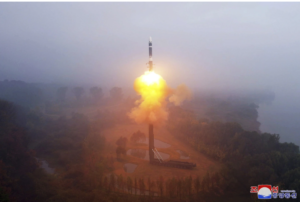North Korea has officially confirmed the successful test of a new intercontinental ballistic missile (ICBM), the Hwasong-19, an event announced by state media on November 1. The announcement comes amid international attention on Pyongyang’s deployment of troops to support Russia in the conflict in Ukraine. This is not only a significant military event but also part of leader Kim Jong Un’s strategy to show off his power.

The Hwasong-19 missile was launched on October 31, with a trajectory believed to be higher than any previous North Korean missile. According to information from the South Korean and Japanese militaries, the missile flew deep into space before falling into the sea between Japan and Russia. North Korea’s KCNA news agency called the Hwasong-19 “the world’s most powerful strategic missile,” reflecting Pyongyang’s pride in its military technology.
The Hwasong-19, like North Korea’s recent ICBMs, is capable of reaching almost anywhere in the United States. Although questions remain about the missile’s guidance capabilities and the ability to protect its nuclear warhead during re-entry, leader Kim Jong Un has said the new ICBM demonstrates North Korea’s dominance in developing and producing nuclear weapons.
The Hwasong-19 will operate alongside the Hwasong-18, a solid-fuel missile introduced last year. Solid-fuel missiles have several advantages, including not needing to be refueled immediately before launch, being easier to operate, and requiring less logistical support than liquid-fuel missiles. Professor Kim Dong Yup of the University of North Korean Studies in Seoul said the Hwasong-19 offers high mobility and durability thanks to its new design and advanced technology.
KCNA images show a large multi-stage rocket being launched from a mobile vehicle. The images, which show the stage separation process and images of the Earth taken from a camera mounted on the rocket, show the sophistication of North Korea’s manufacturing technology. Professor Kim said the Hwasong-19’s longer-than-usual length could be due to its larger fuel capacity, allowing it to have increased thrust and range. Although North Korea’s missile is currently capable of reaching anywhere in the United States, the increased payload capacity of the Hwasong-19 could be aimed at carrying a heavier warhead or multiple nuclear warheads at once.
According to KCNA, the Hwasong-19 flew 1,001.2 km in 85 minutes and 56 seconds, reaching a maximum altitude of 7,687.5 km before falling into the sea east of the Korean Peninsula. The launch, which came just ahead of the US presidential election on November 5, was quickly condemned by Washington and its allies, including South Korea, Japan and the United Nations.
Ankit Panda of the Carnegie Endowment for International Peace said the launch further affirmed North Korea’s strategic deterrence capabilities and sent a strong message to the US. A spokesman for South Korea’s Unification Ministry also said the launch could have multiple purposes, from demonstrating military technology to pressuring Washington and distracting from the deployment of North Korean troops in Ukraine.
Ukrainian President Volodymyr Zelensky has strongly criticized the allies’ weak response to Russia’s involvement in the conflict, while expressing concern about Moscow’s possible transfer of military technology to Pyongyang. Meanwhile, both Russia and North Korea have asserted their right to support each other amid the current tensions.
US Defense Secretary Lloyd Austin said the Pentagon was in the early stages of assessing the ICBM launch and there was no indication of Russian involvement. KCNA stressed that the launch did not pose a security risk to neighboring countries and was seen as a reasonable military step in the face of threats from North Korea’s rivals.
Professor Kim Dong Yup said Russia may provide some experts to assist North Korea in testing or adjusting the missile, but the possibility of sharing sensitive technology between the two countries is unlikely. Still, the event reflects rising tensions in the region and the potential for future arms races.
The successful test of the Hwasong-19 is not only a step forward in North Korea’s military technology but also part of a broader political strategy by leader Kim Jong Un to assert the country’s position on the international stage. This event will certainly continue to attract the attention of analysts and politicians amid the increasingly complex geopolitical situation.





